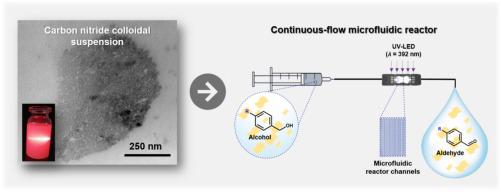Applied Catalysis A: General ( IF 4.7 ) Pub Date : 2020-10-03 , DOI: 10.1016/j.apcata.2020.117844 Maria J. Lima , Adrián M.T. Silva , Cláudia G. Silva , Joaquim L. Faria

|
Benzyl alcohol and a set of para-substituted derivatives (–NO2, –Cl, −CH3, −OCH3 and −OH) were converted to the corresponding aldehydes in a commercial continuous-flow microfluidic reactor. Due to the dimension and the rigidity of the commercial microfluidic reactor channels, a stable suspension with few-layer graphitic carbon nitride nanoparticles (GCN-TS) was used to avoid the blockage of the photocatalyst in the channels of the reactor. Preliminary photocatalytic batch experiments revealed that different reaction yields were obtained depending on the aromatic ring activating/deactivating nature of the substituent groups. Regarding the experiments under continuous-flow, the highest aldehyde production was obtained for the reactions with 4-methoxybenzyl alcohol as starting molecule, corresponding to 0.19 mM at a retention time of merely 0.75 min. The results show the possibility of employing microfluidic reactors for the selective photocatalytic conversion of aromatic alcohols for both process intensification and screening applications due to the drastic decrease of reaction time.
中文翻译:

微流体反应器在连续光催化选择性合成芳族醛中的应用
苄醇和一组对位取代的衍生物(-NO 2,-Cl,-CH 3,-OCH 3和-OH)在商业连续流微流体反应器中转化为相应的醛。由于商业微流体反应器通道的尺寸和刚性,使用具有少层石墨氮化碳纳米颗粒(GCN-TS)的稳定悬浮液来避免反应器通道中光催化剂的阻塞。初步的光催化分批实验表明,根据取代基的芳环活化/失活性质,可获得不同的反应产率。关于在连续流动下的实验,对于以4-甲氧基苄醇为起始分子的反应,获得了最高的醛产生量,相当于在仅0.75分钟的保留时间下为0.19mM。











































 京公网安备 11010802027423号
京公网安备 11010802027423号